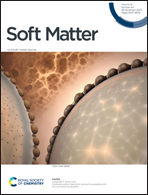Effect of confinement and topology: 2-TIPS vs. MIPS†
Abstract
2-TIPS (two temperature induced phase separation) refers to the phase separation phenomenon observed in mixtures of active and passive particles which are modelled using scalar activity. The active particles are connected to a thermostat at high temperature while the passive particles are connected to the thermostat at low temperature and the relative temperature difference between “hot” and “cold” particles is taken as the measure of the activity χ of the non-equilibrium system. The study of such binary mixtures of hot and cold particles under various kinds of confinement is an important problem in many physical and biological processes. The nature and extent of phase separation are heavily influenced by the geometry of confinement, activity, and density of the non-equilibrium binary mixture. Investigating such 3D binary mixtures confined by parallel walls, we observe that the active and passive particles phase separate, but the extent of phase separation is reduced compared to bulk phase separation at high densities and enhanced at low densities. However, when the binary mixture of active and passive particles is confined inside a spherical cavity, the phase separation is radial for small radii of the confining sphere and the extent of phase separation is higher compared to their bulk counterparts. Confinement leads to interesting properties in the passive (cold) region like enhanced layering and high compression in the direction parallel to the confining wall. In 2D, both the bulk and confined systems of the binary mixture show a significant decrement in the extent of phase separation at higher densities. This observation is attributed to the trapping of active particles inside the passive cluster, which increases with density. Thus the 2D systems show structures more akin to dense-dilute phase co-existence, which is observed in motility induced phase separation in 2D active systems. The binary mixture constrained on the spherical surface also shows similar phase co-existence. Our analyses reveal that the coexistent densities observed in 2-TIPS on the spherical surface agree with the findings of previous studies on MIPS in active systems on a sphere.

- This article is part of the themed collection: Celebrating the scientific accomplishments of RSC Fellows


 Please wait while we load your content...
Please wait while we load your content...